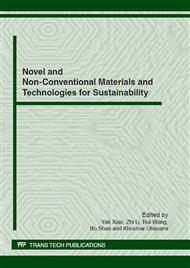p.844
p.850
p.858
p.864
p.870
p.875
p.881
p.887
p.892
Design and Use of the Joint between Concrete-Filled Square Steel Tubular Special-Shaped Columns and Steel Beams
Abstract:
Environmentally sustainable building construction has experienced significant growth during the past 10 years. The public is becoming more aware of the benefits of green construction, and green building is leading to changes in the way of owners, designers, contractors, and approach of the design, construction. Concrete-filled square steel tubular special shaped columns - steel beams residence installing efficient and light heat insulation wall is welcome for both owners and designers because of the columns having the same thickness with limb-filled walls, no-shocked indoor, easy to decoration and furniture layout, increasing in the actual using areas and saving carbon. The composite frame fully develops the merits of steel and concrete, and thus is reasonable and economical from both structural and construction viewpoints. The connection region as main force transfer component is key to the research of frame. Compared with the joint of ordinary reinforced concrete special shaped frame, the joint between concrete-filled square steel tubular special-shaped columns and steel beams has the advantage of better ductility , higher loading capacity, uncomplicated reinforcement disposing and convenient in construction. This paper discusses the features of concrete-filled square steel tubular special shaped columns - steel beams frame, and the design and use of beam-column joint. From the experimental study on seismic behavior of the joint, it is shown that the joint has strong energy dissipation capacity and higher loading capacity. So it is expected it could play an important role in residence structures. This study is helpful for further study of the design and use of the joint between concrete-filled square steel tubular special-shaped columns and steel beams.
Info:
Periodical:
Pages:
870-874
Citation:
Online since:
June 2012
Authors:
Price:
Сopyright:
© 2012 Trans Tech Publications Ltd. All Rights Reserved
Share:
Citation:


